Critical Analysis: Digital Transformation, CRM, and Big Data in SMEs
VerifiedAdded on 2023/06/08
|8
|2411
|174
AI Summary
This assignment comprises four blog posts that critically analyze various aspects of digital business transformation. The first post examines the key differences between traditional marketing and customer relationship management (CRM), highlighting the shift from sales-focused approaches to long-term relationship building and two-way interaction. The second post delves into the challenges of implementing big data-based decision-making in small and medium-sized enterprises (SMEs), focusing on the parameters of volume, velocity, and variability, and addressing issues such as lack of skilled professionals and insufficient understanding of massive data. The third post analyzes the trade-off between trust and user-friendliness for online businesses, emphasizing the importance of confidentiality, availability, and integrity in building customer trust. Finally, the fourth post critiques the role of customer experience and the automation of offline processes in the successful digital transformation of organizations, underscoring the need for businesses to adapt to rapidly changing customer expectations and leverage emerging technologies. Desklib provides access to this assignment and many other resources for students.

Blog Posts
Paraphrase This Document
Need a fresh take? Get an instant paraphrase of this document with our AI Paraphraser
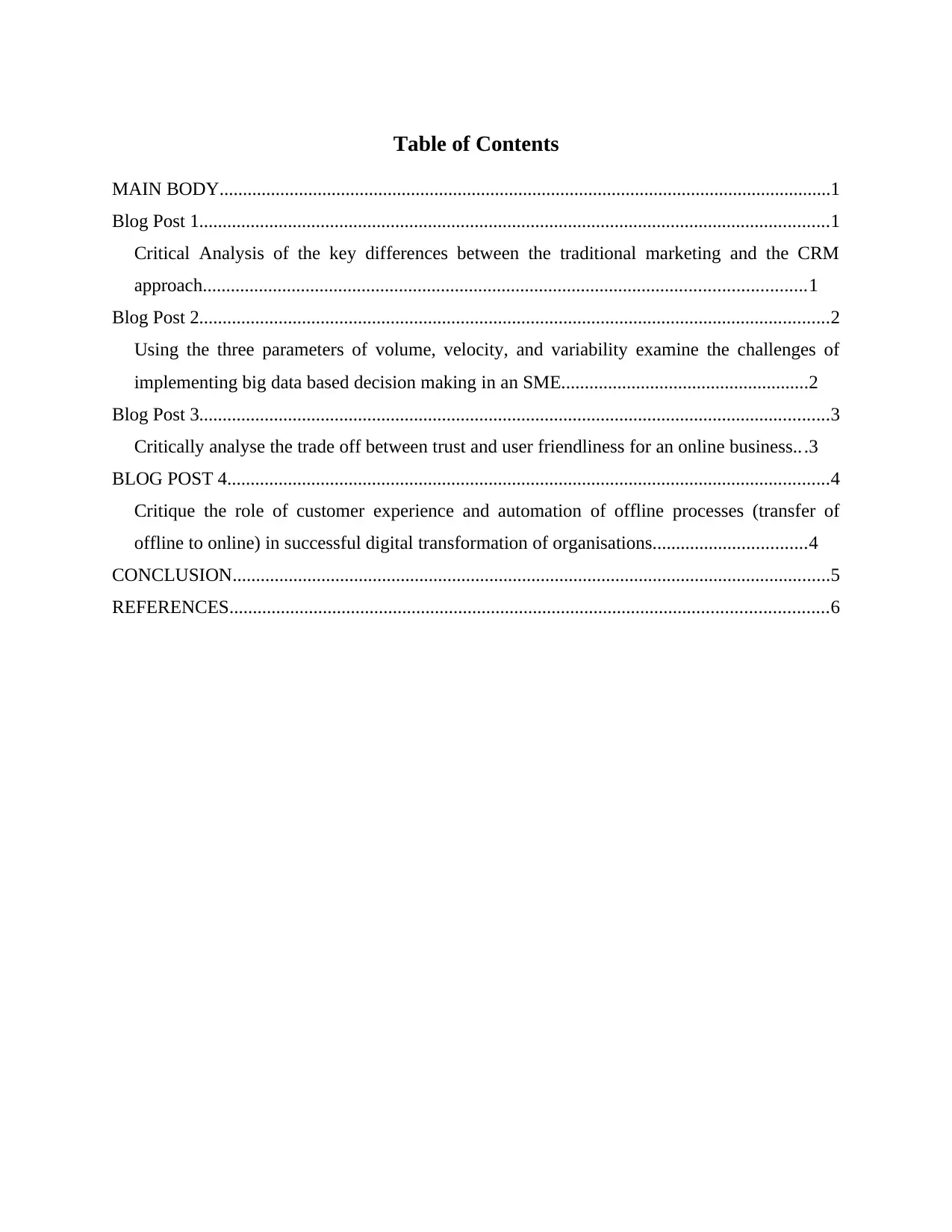
Table of Contents
MAIN BODY...................................................................................................................................1
Blog Post 1.......................................................................................................................................1
Critical Analysis of the key differences between the traditional marketing and the CRM
approach.................................................................................................................................1
Blog Post 2.......................................................................................................................................2
Using the three parameters of volume, velocity, and variability examine the challenges of
implementing big data based decision making in an SME.....................................................2
Blog Post 3.......................................................................................................................................3
Critically analyse the trade off between trust and user friendliness for an online business...3
BLOG POST 4.................................................................................................................................4
Critique the role of customer experience and automation of offline processes (transfer of
offline to online) in successful digital transformation of organisations.................................4
CONCLUSION................................................................................................................................5
REFERENCES................................................................................................................................6
MAIN BODY...................................................................................................................................1
Blog Post 1.......................................................................................................................................1
Critical Analysis of the key differences between the traditional marketing and the CRM
approach.................................................................................................................................1
Blog Post 2.......................................................................................................................................2
Using the three parameters of volume, velocity, and variability examine the challenges of
implementing big data based decision making in an SME.....................................................2
Blog Post 3.......................................................................................................................................3
Critically analyse the trade off between trust and user friendliness for an online business...3
BLOG POST 4.................................................................................................................................4
Critique the role of customer experience and automation of offline processes (transfer of
offline to online) in successful digital transformation of organisations.................................4
CONCLUSION................................................................................................................................5
REFERENCES................................................................................................................................6
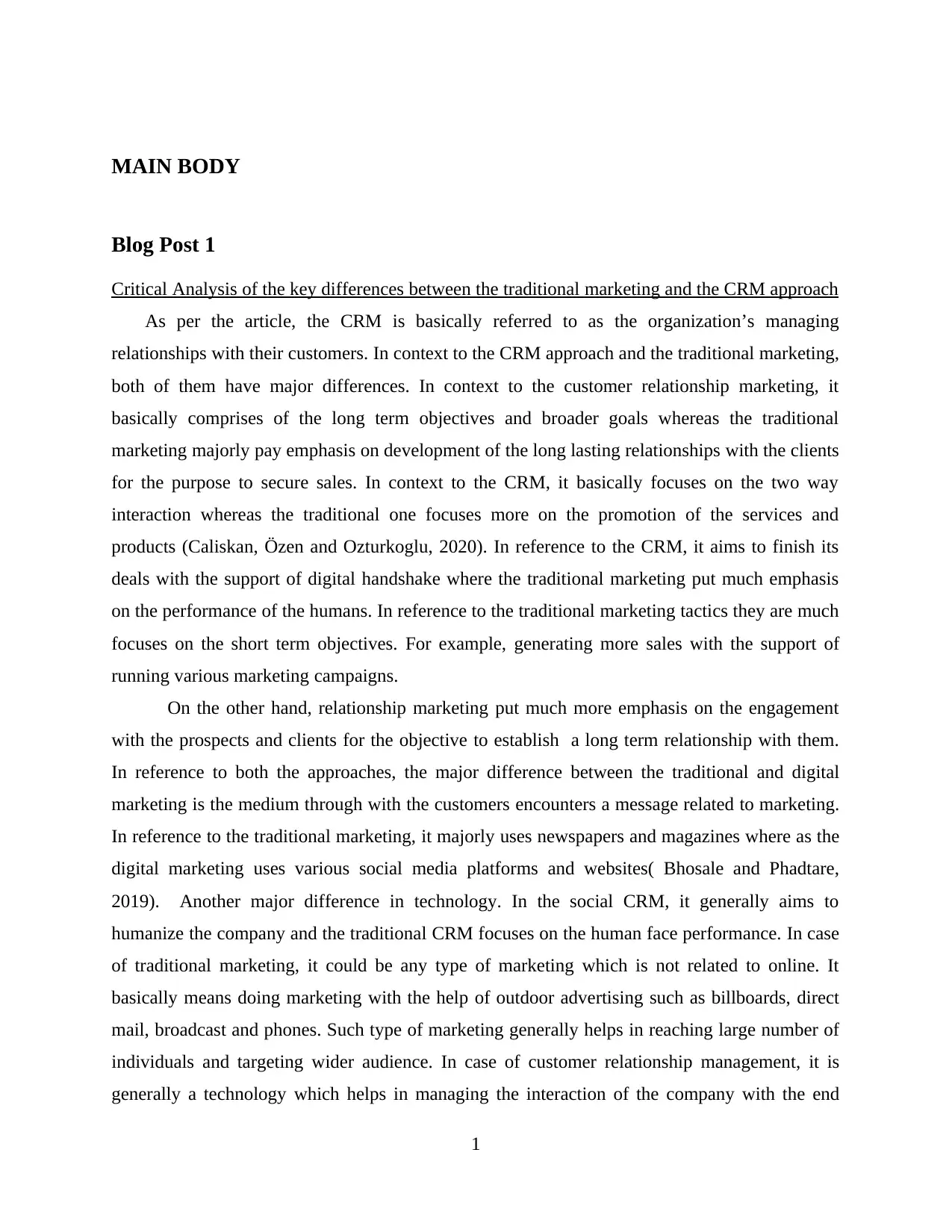
MAIN BODY
Blog Post 1
Critical Analysis of the key differences between the traditional marketing and the CRM approach
As per the article, the CRM is basically referred to as the organization’s managing
relationships with their customers. In context to the CRM approach and the traditional marketing,
both of them have major differences. In context to the customer relationship marketing, it
basically comprises of the long term objectives and broader goals whereas the traditional
marketing majorly pay emphasis on development of the long lasting relationships with the clients
for the purpose to secure sales. In context to the CRM, it basically focuses on the two way
interaction whereas the traditional one focuses more on the promotion of the services and
products (Caliskan, Özen and Ozturkoglu, 2020). In reference to the CRM, it aims to finish its
deals with the support of digital handshake where the traditional marketing put much emphasis
on the performance of the humans. In reference to the traditional marketing tactics they are much
focuses on the short term objectives. For example, generating more sales with the support of
running various marketing campaigns.
On the other hand, relationship marketing put much more emphasis on the engagement
with the prospects and clients for the objective to establish a long term relationship with them.
In reference to both the approaches, the major difference between the traditional and digital
marketing is the medium through with the customers encounters a message related to marketing.
In reference to the traditional marketing, it majorly uses newspapers and magazines where as the
digital marketing uses various social media platforms and websites( Bhosale and Phadtare,
2019). Another major difference in technology. In the social CRM, it generally aims to
humanize the company and the traditional CRM focuses on the human face performance. In case
of traditional marketing, it could be any type of marketing which is not related to online. It
basically means doing marketing with the help of outdoor advertising such as billboards, direct
mail, broadcast and phones. Such type of marketing generally helps in reaching large number of
individuals and targeting wider audience. In case of customer relationship management, it is
generally a technology which helps in managing the interaction of the company with the end
1
Blog Post 1
Critical Analysis of the key differences between the traditional marketing and the CRM approach
As per the article, the CRM is basically referred to as the organization’s managing
relationships with their customers. In context to the CRM approach and the traditional marketing,
both of them have major differences. In context to the customer relationship marketing, it
basically comprises of the long term objectives and broader goals whereas the traditional
marketing majorly pay emphasis on development of the long lasting relationships with the clients
for the purpose to secure sales. In context to the CRM, it basically focuses on the two way
interaction whereas the traditional one focuses more on the promotion of the services and
products (Caliskan, Özen and Ozturkoglu, 2020). In reference to the CRM, it aims to finish its
deals with the support of digital handshake where the traditional marketing put much emphasis
on the performance of the humans. In reference to the traditional marketing tactics they are much
focuses on the short term objectives. For example, generating more sales with the support of
running various marketing campaigns.
On the other hand, relationship marketing put much more emphasis on the engagement
with the prospects and clients for the objective to establish a long term relationship with them.
In reference to both the approaches, the major difference between the traditional and digital
marketing is the medium through with the customers encounters a message related to marketing.
In reference to the traditional marketing, it majorly uses newspapers and magazines where as the
digital marketing uses various social media platforms and websites( Bhosale and Phadtare,
2019). Another major difference in technology. In the social CRM, it generally aims to
humanize the company and the traditional CRM focuses on the human face performance. In case
of traditional marketing, it could be any type of marketing which is not related to online. It
basically means doing marketing with the help of outdoor advertising such as billboards, direct
mail, broadcast and phones. Such type of marketing generally helps in reaching large number of
individuals and targeting wider audience. In case of customer relationship management, it is
generally a technology which helps in managing the interaction of the company with the end
1
⊘ This is a preview!⊘
Do you want full access?
Subscribe today to unlock all pages.

Trusted by 1+ million students worldwide
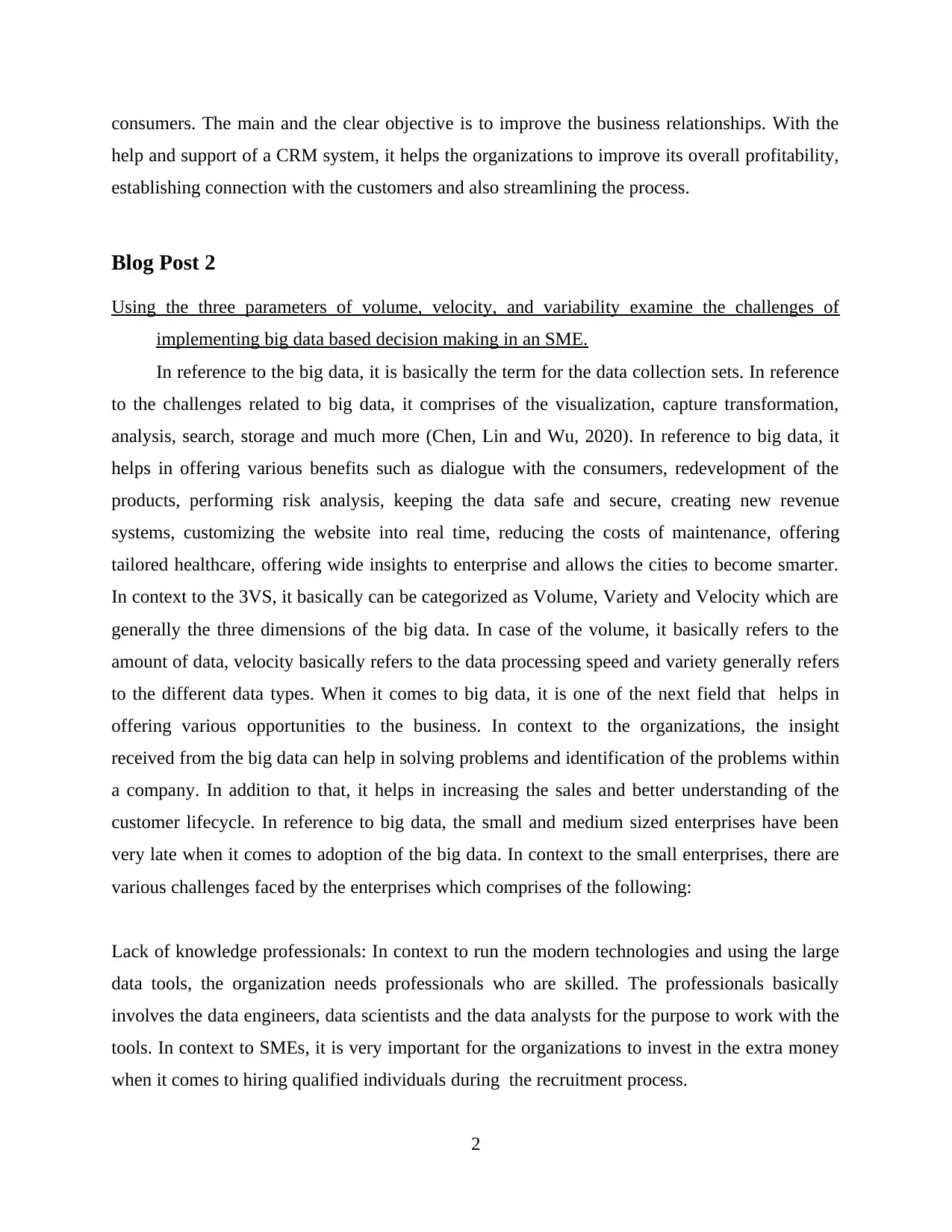
consumers. The main and the clear objective is to improve the business relationships. With the
help and support of a CRM system, it helps the organizations to improve its overall profitability,
establishing connection with the customers and also streamlining the process.
Blog Post 2
Using the three parameters of volume, velocity, and variability examine the challenges of
implementing big data based decision making in an SME.
In reference to the big data, it is basically the term for the data collection sets. In reference
to the challenges related to big data, it comprises of the visualization, capture transformation,
analysis, search, storage and much more (Chen, Lin and Wu, 2020). In reference to big data, it
helps in offering various benefits such as dialogue with the consumers, redevelopment of the
products, performing risk analysis, keeping the data safe and secure, creating new revenue
systems, customizing the website into real time, reducing the costs of maintenance, offering
tailored healthcare, offering wide insights to enterprise and allows the cities to become smarter.
In context to the 3VS, it basically can be categorized as Volume, Variety and Velocity which are
generally the three dimensions of the big data. In case of the volume, it basically refers to the
amount of data, velocity basically refers to the data processing speed and variety generally refers
to the different data types. When it comes to big data, it is one of the next field that helps in
offering various opportunities to the business. In context to the organizations, the insight
received from the big data can help in solving problems and identification of the problems within
a company. In addition to that, it helps in increasing the sales and better understanding of the
customer lifecycle. In reference to big data, the small and medium sized enterprises have been
very late when it comes to adoption of the big data. In context to the small enterprises, there are
various challenges faced by the enterprises which comprises of the following:
Lack of knowledge professionals: In context to run the modern technologies and using the large
data tools, the organization needs professionals who are skilled. The professionals basically
involves the data engineers, data scientists and the data analysts for the purpose to work with the
tools. In context to SMEs, it is very important for the organizations to invest in the extra money
when it comes to hiring qualified individuals during the recruitment process.
2
help and support of a CRM system, it helps the organizations to improve its overall profitability,
establishing connection with the customers and also streamlining the process.
Blog Post 2
Using the three parameters of volume, velocity, and variability examine the challenges of
implementing big data based decision making in an SME.
In reference to the big data, it is basically the term for the data collection sets. In reference
to the challenges related to big data, it comprises of the visualization, capture transformation,
analysis, search, storage and much more (Chen, Lin and Wu, 2020). In reference to big data, it
helps in offering various benefits such as dialogue with the consumers, redevelopment of the
products, performing risk analysis, keeping the data safe and secure, creating new revenue
systems, customizing the website into real time, reducing the costs of maintenance, offering
tailored healthcare, offering wide insights to enterprise and allows the cities to become smarter.
In context to the 3VS, it basically can be categorized as Volume, Variety and Velocity which are
generally the three dimensions of the big data. In case of the volume, it basically refers to the
amount of data, velocity basically refers to the data processing speed and variety generally refers
to the different data types. When it comes to big data, it is one of the next field that helps in
offering various opportunities to the business. In context to the organizations, the insight
received from the big data can help in solving problems and identification of the problems within
a company. In addition to that, it helps in increasing the sales and better understanding of the
customer lifecycle. In reference to big data, the small and medium sized enterprises have been
very late when it comes to adoption of the big data. In context to the small enterprises, there are
various challenges faced by the enterprises which comprises of the following:
Lack of knowledge professionals: In context to run the modern technologies and using the large
data tools, the organization needs professionals who are skilled. The professionals basically
involves the data engineers, data scientists and the data analysts for the purpose to work with the
tools. In context to SMEs, it is very important for the organizations to invest in the extra money
when it comes to hiring qualified individuals during the recruitment process.
2
Paraphrase This Document
Need a fresh take? Get an instant paraphrase of this document with our AI Paraphraser
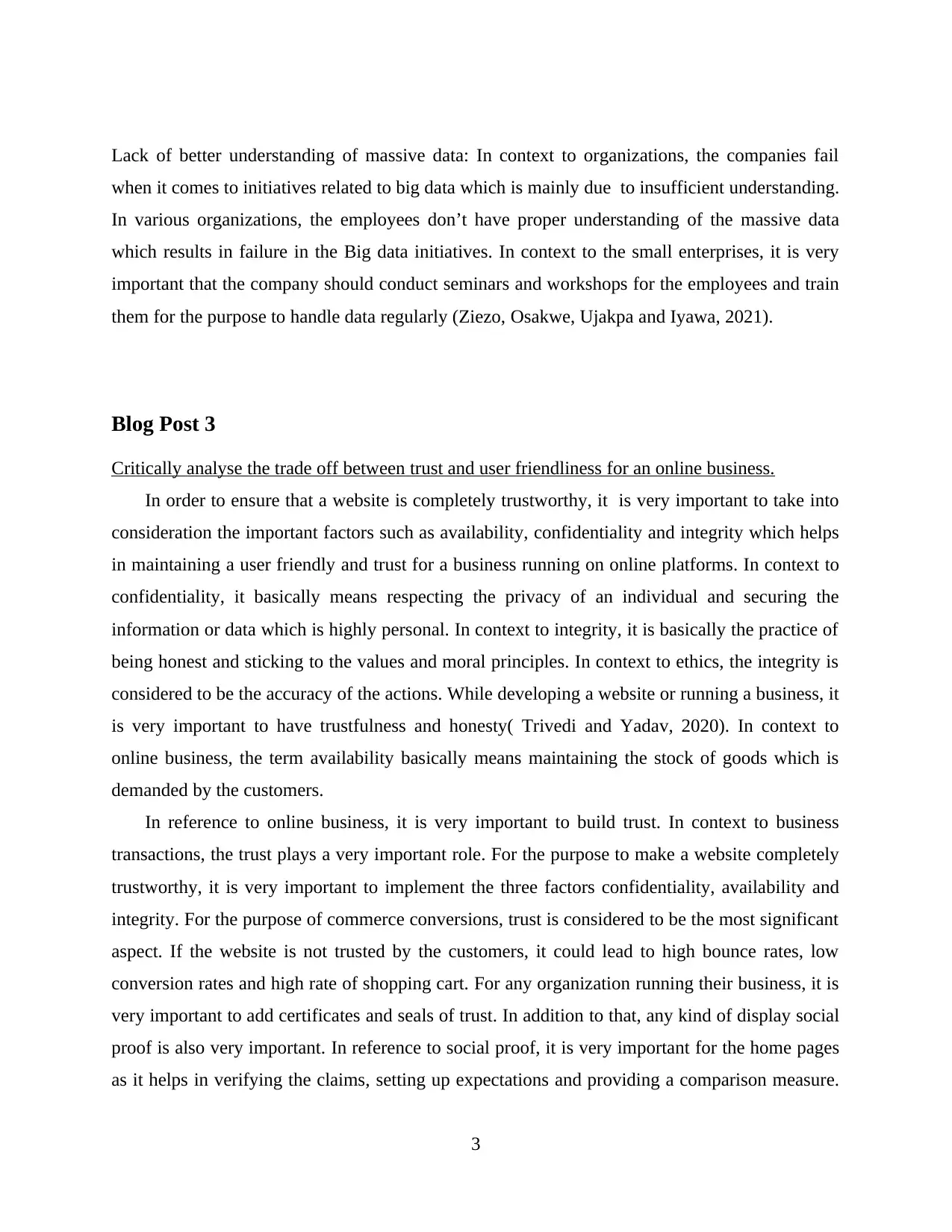
Lack of better understanding of massive data: In context to organizations, the companies fail
when it comes to initiatives related to big data which is mainly due to insufficient understanding.
In various organizations, the employees don’t have proper understanding of the massive data
which results in failure in the Big data initiatives. In context to the small enterprises, it is very
important that the company should conduct seminars and workshops for the employees and train
them for the purpose to handle data regularly (Ziezo, Osakwe, Ujakpa and Iyawa, 2021).
Blog Post 3
Critically analyse the trade off between trust and user friendliness for an online business.
In order to ensure that a website is completely trustworthy, it is very important to take into
consideration the important factors such as availability, confidentiality and integrity which helps
in maintaining a user friendly and trust for a business running on online platforms. In context to
confidentiality, it basically means respecting the privacy of an individual and securing the
information or data which is highly personal. In context to integrity, it is basically the practice of
being honest and sticking to the values and moral principles. In context to ethics, the integrity is
considered to be the accuracy of the actions. While developing a website or running a business, it
is very important to have trustfulness and honesty( Trivedi and Yadav, 2020). In context to
online business, the term availability basically means maintaining the stock of goods which is
demanded by the customers.
In reference to online business, it is very important to build trust. In context to business
transactions, the trust plays a very important role. For the purpose to make a website completely
trustworthy, it is very important to implement the three factors confidentiality, availability and
integrity. For the purpose of commerce conversions, trust is considered to be the most significant
aspect. If the website is not trusted by the customers, it could lead to high bounce rates, low
conversion rates and high rate of shopping cart. For any organization running their business, it is
very important to add certificates and seals of trust. In addition to that, any kind of display social
proof is also very important. In reference to social proof, it is very important for the home pages
as it helps in verifying the claims, setting up expectations and providing a comparison measure.
3
when it comes to initiatives related to big data which is mainly due to insufficient understanding.
In various organizations, the employees don’t have proper understanding of the massive data
which results in failure in the Big data initiatives. In context to the small enterprises, it is very
important that the company should conduct seminars and workshops for the employees and train
them for the purpose to handle data regularly (Ziezo, Osakwe, Ujakpa and Iyawa, 2021).
Blog Post 3
Critically analyse the trade off between trust and user friendliness for an online business.
In order to ensure that a website is completely trustworthy, it is very important to take into
consideration the important factors such as availability, confidentiality and integrity which helps
in maintaining a user friendly and trust for a business running on online platforms. In context to
confidentiality, it basically means respecting the privacy of an individual and securing the
information or data which is highly personal. In context to integrity, it is basically the practice of
being honest and sticking to the values and moral principles. In context to ethics, the integrity is
considered to be the accuracy of the actions. While developing a website or running a business, it
is very important to have trustfulness and honesty( Trivedi and Yadav, 2020). In context to
online business, the term availability basically means maintaining the stock of goods which is
demanded by the customers.
In reference to online business, it is very important to build trust. In context to business
transactions, the trust plays a very important role. For the purpose to make a website completely
trustworthy, it is very important to implement the three factors confidentiality, availability and
integrity. For the purpose of commerce conversions, trust is considered to be the most significant
aspect. If the website is not trusted by the customers, it could lead to high bounce rates, low
conversion rates and high rate of shopping cart. For any organization running their business, it is
very important to add certificates and seals of trust. In addition to that, any kind of display social
proof is also very important. In reference to social proof, it is very important for the home pages
as it helps in verifying the claims, setting up expectations and providing a comparison measure.
3
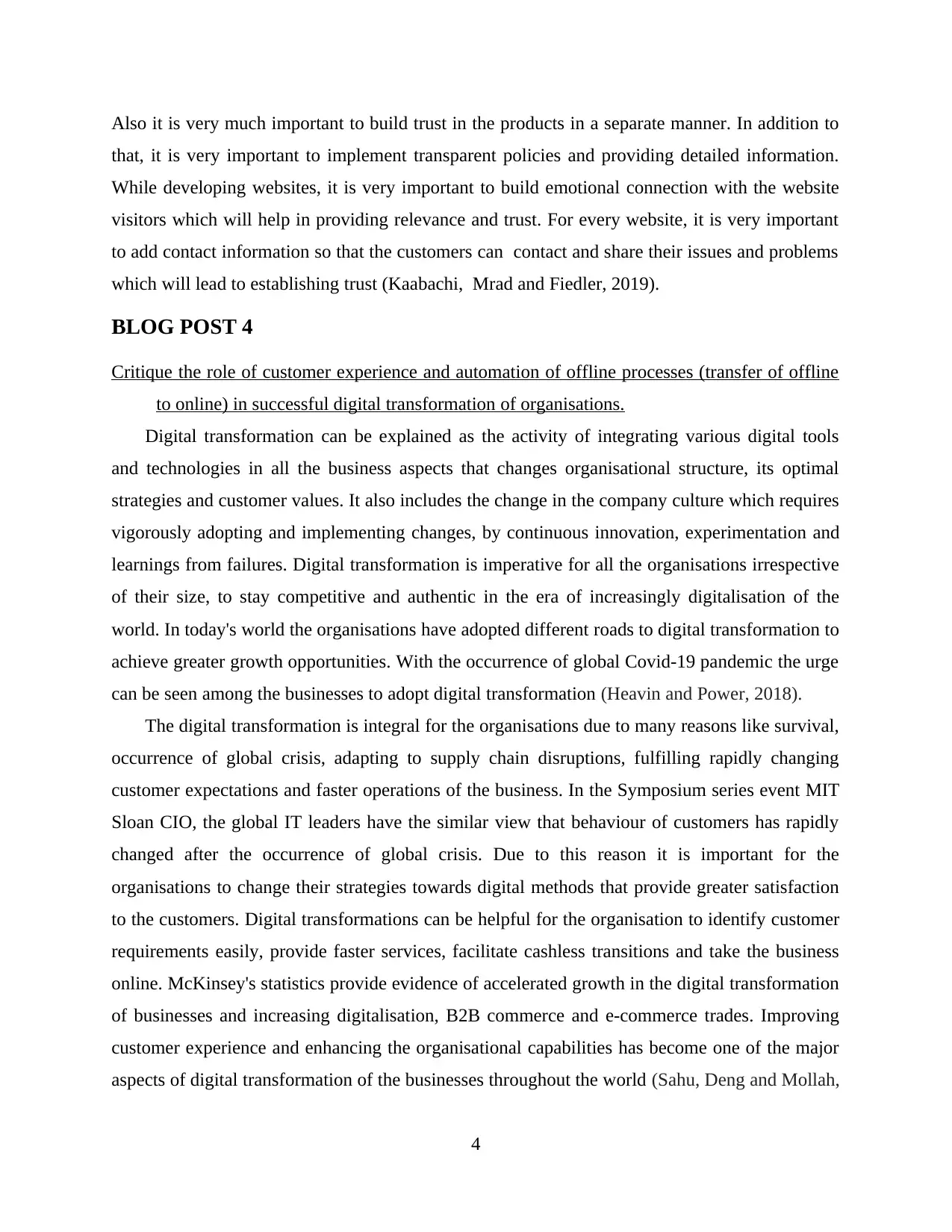
Also it is very much important to build trust in the products in a separate manner. In addition to
that, it is very important to implement transparent policies and providing detailed information.
While developing websites, it is very important to build emotional connection with the website
visitors which will help in providing relevance and trust. For every website, it is very important
to add contact information so that the customers can contact and share their issues and problems
which will lead to establishing trust (Kaabachi, Mrad and Fiedler, 2019).
BLOG POST 4
Critique the role of customer experience and automation of offline processes (transfer of offline
to online) in successful digital transformation of organisations.
Digital transformation can be explained as the activity of integrating various digital tools
and technologies in all the business aspects that changes organisational structure, its optimal
strategies and customer values. It also includes the change in the company culture which requires
vigorously adopting and implementing changes, by continuous innovation, experimentation and
learnings from failures. Digital transformation is imperative for all the organisations irrespective
of their size, to stay competitive and authentic in the era of increasingly digitalisation of the
world. In today's world the organisations have adopted different roads to digital transformation to
achieve greater growth opportunities. With the occurrence of global Covid-19 pandemic the urge
can be seen among the businesses to adopt digital transformation (Heavin and Power, 2018).
The digital transformation is integral for the organisations due to many reasons like survival,
occurrence of global crisis, adapting to supply chain disruptions, fulfilling rapidly changing
customer expectations and faster operations of the business. In the Symposium series event MIT
Sloan CIO, the global IT leaders have the similar view that behaviour of customers has rapidly
changed after the occurrence of global crisis. Due to this reason it is important for the
organisations to change their strategies towards digital methods that provide greater satisfaction
to the customers. Digital transformations can be helpful for the organisation to identify customer
requirements easily, provide faster services, facilitate cashless transitions and take the business
online. McKinsey's statistics provide evidence of accelerated growth in the digital transformation
of businesses and increasing digitalisation, B2B commerce and e-commerce trades. Improving
customer experience and enhancing the organisational capabilities has become one of the major
aspects of digital transformation of the businesses throughout the world (Sahu, Deng and Mollah,
4
that, it is very important to implement transparent policies and providing detailed information.
While developing websites, it is very important to build emotional connection with the website
visitors which will help in providing relevance and trust. For every website, it is very important
to add contact information so that the customers can contact and share their issues and problems
which will lead to establishing trust (Kaabachi, Mrad and Fiedler, 2019).
BLOG POST 4
Critique the role of customer experience and automation of offline processes (transfer of offline
to online) in successful digital transformation of organisations.
Digital transformation can be explained as the activity of integrating various digital tools
and technologies in all the business aspects that changes organisational structure, its optimal
strategies and customer values. It also includes the change in the company culture which requires
vigorously adopting and implementing changes, by continuous innovation, experimentation and
learnings from failures. Digital transformation is imperative for all the organisations irrespective
of their size, to stay competitive and authentic in the era of increasingly digitalisation of the
world. In today's world the organisations have adopted different roads to digital transformation to
achieve greater growth opportunities. With the occurrence of global Covid-19 pandemic the urge
can be seen among the businesses to adopt digital transformation (Heavin and Power, 2018).
The digital transformation is integral for the organisations due to many reasons like survival,
occurrence of global crisis, adapting to supply chain disruptions, fulfilling rapidly changing
customer expectations and faster operations of the business. In the Symposium series event MIT
Sloan CIO, the global IT leaders have the similar view that behaviour of customers has rapidly
changed after the occurrence of global crisis. Due to this reason it is important for the
organisations to change their strategies towards digital methods that provide greater satisfaction
to the customers. Digital transformations can be helpful for the organisation to identify customer
requirements easily, provide faster services, facilitate cashless transitions and take the business
online. McKinsey's statistics provide evidence of accelerated growth in the digital transformation
of businesses and increasing digitalisation, B2B commerce and e-commerce trades. Improving
customer experience and enhancing the organisational capabilities has become one of the major
aspects of digital transformation of the businesses throughout the world (Sahu, Deng and Mollah,
4
⊘ This is a preview!⊘
Do you want full access?
Subscribe today to unlock all pages.

Trusted by 1+ million students worldwide
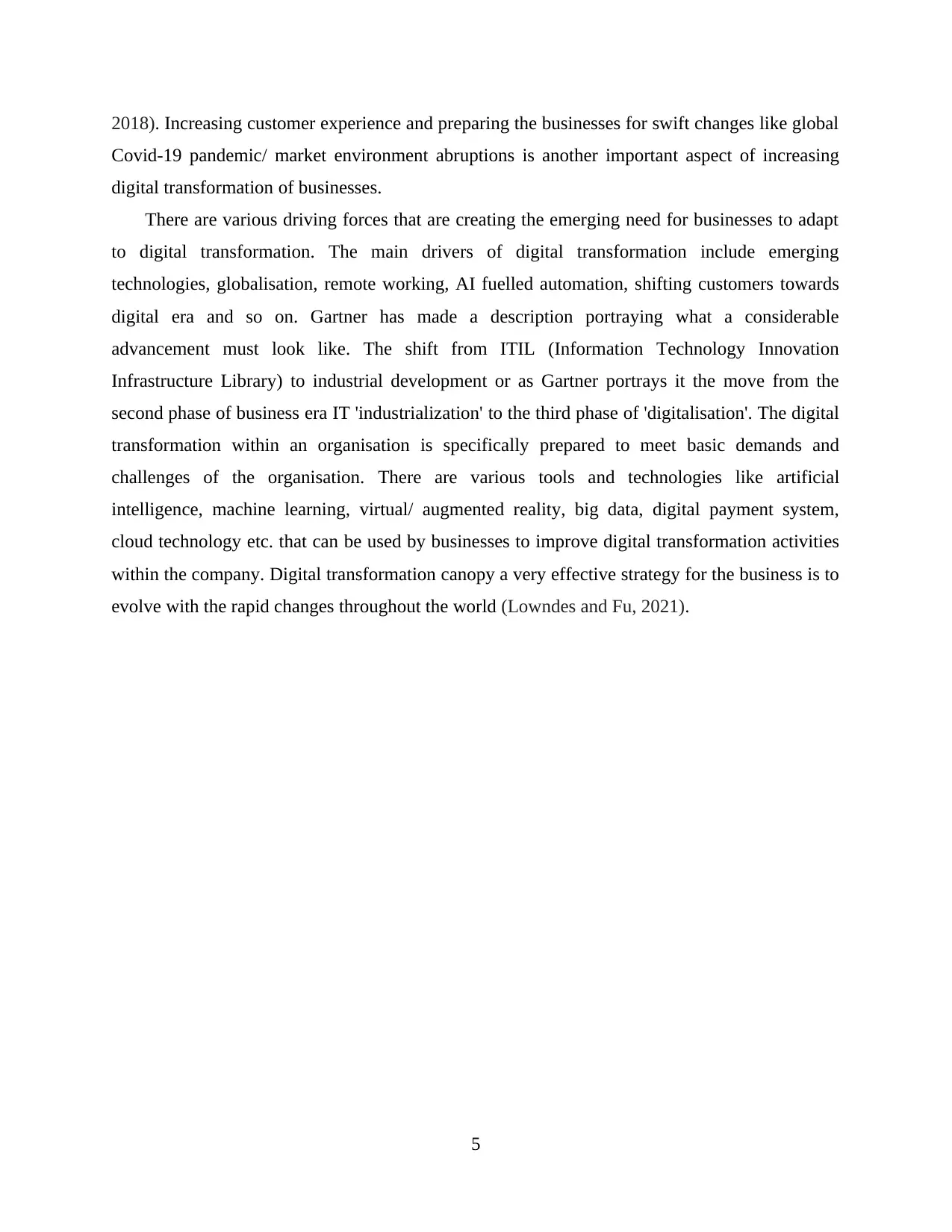
2018). Increasing customer experience and preparing the businesses for swift changes like global
Covid-19 pandemic/ market environment abruptions is another important aspect of increasing
digital transformation of businesses.
There are various driving forces that are creating the emerging need for businesses to adapt
to digital transformation. The main drivers of digital transformation include emerging
technologies, globalisation, remote working, AI fuelled automation, shifting customers towards
digital era and so on. Gartner has made a description portraying what a considerable
advancement must look like. The shift from ITIL (Information Technology Innovation
Infrastructure Library) to industrial development or as Gartner portrays it the move from the
second phase of business era IT 'industrialization' to the third phase of 'digitalisation'. The digital
transformation within an organisation is specifically prepared to meet basic demands and
challenges of the organisation. There are various tools and technologies like artificial
intelligence, machine learning, virtual/ augmented reality, big data, digital payment system,
cloud technology etc. that can be used by businesses to improve digital transformation activities
within the company. Digital transformation canopy a very effective strategy for the business is to
evolve with the rapid changes throughout the world (Lowndes and Fu, 2021).
5
Covid-19 pandemic/ market environment abruptions is another important aspect of increasing
digital transformation of businesses.
There are various driving forces that are creating the emerging need for businesses to adapt
to digital transformation. The main drivers of digital transformation include emerging
technologies, globalisation, remote working, AI fuelled automation, shifting customers towards
digital era and so on. Gartner has made a description portraying what a considerable
advancement must look like. The shift from ITIL (Information Technology Innovation
Infrastructure Library) to industrial development or as Gartner portrays it the move from the
second phase of business era IT 'industrialization' to the third phase of 'digitalisation'. The digital
transformation within an organisation is specifically prepared to meet basic demands and
challenges of the organisation. There are various tools and technologies like artificial
intelligence, machine learning, virtual/ augmented reality, big data, digital payment system,
cloud technology etc. that can be used by businesses to improve digital transformation activities
within the company. Digital transformation canopy a very effective strategy for the business is to
evolve with the rapid changes throughout the world (Lowndes and Fu, 2021).
5
Paraphrase This Document
Need a fresh take? Get an instant paraphrase of this document with our AI Paraphraser
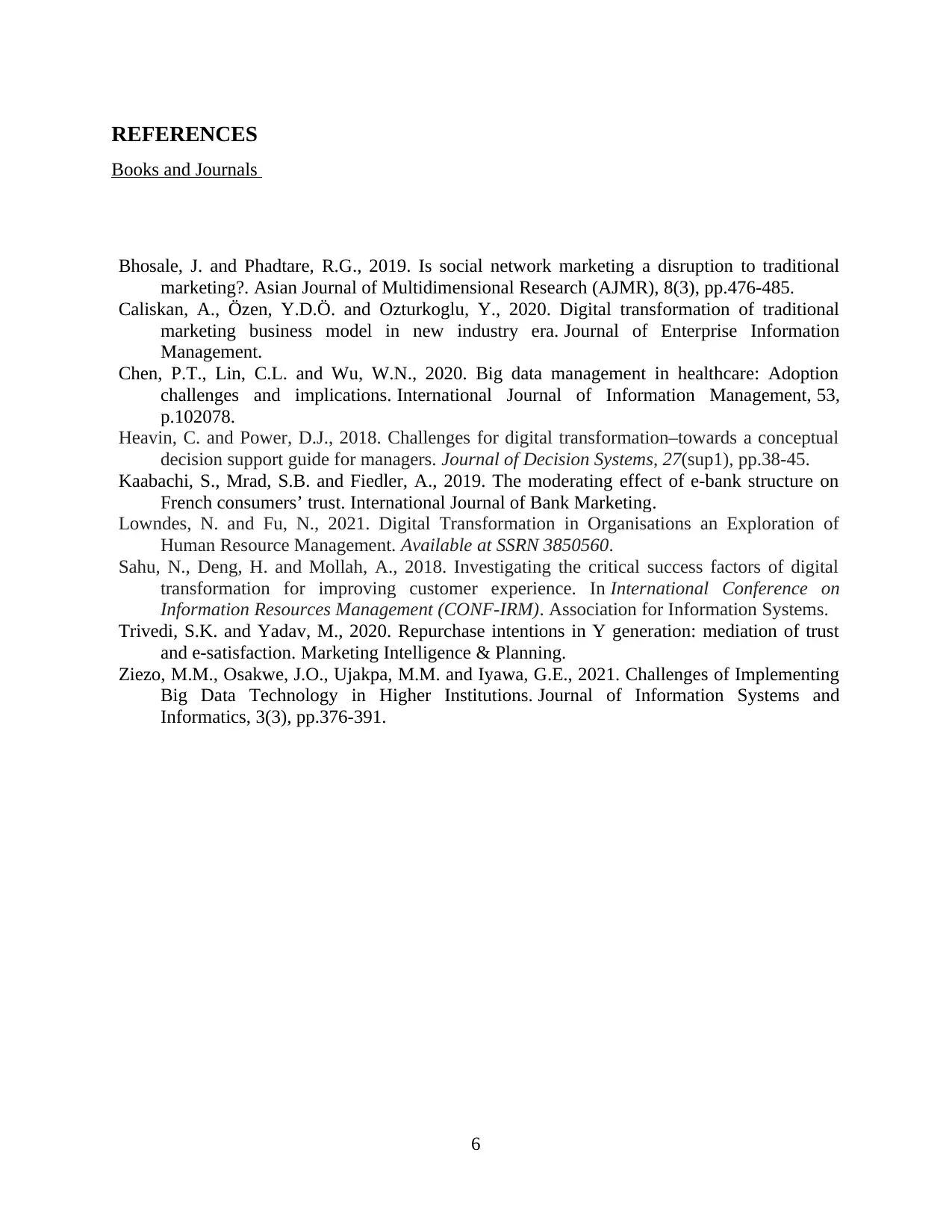
REFERENCES
Books and Journals
Bhosale, J. and Phadtare, R.G., 2019. Is social network marketing a disruption to traditional
marketing?. Asian Journal of Multidimensional Research (AJMR), 8(3), pp.476-485.
Caliskan, A., Özen, Y.D.Ö. and Ozturkoglu, Y., 2020. Digital transformation of traditional
marketing business model in new industry era. Journal of Enterprise Information
Management.
Chen, P.T., Lin, C.L. and Wu, W.N., 2020. Big data management in healthcare: Adoption
challenges and implications. International Journal of Information Management, 53,
p.102078.
Heavin, C. and Power, D.J., 2018. Challenges for digital transformation–towards a conceptual
decision support guide for managers. Journal of Decision Systems, 27(sup1), pp.38-45.
Kaabachi, S., Mrad, S.B. and Fiedler, A., 2019. The moderating effect of e-bank structure on
French consumers’ trust. International Journal of Bank Marketing.
Lowndes, N. and Fu, N., 2021. Digital Transformation in Organisations an Exploration of
Human Resource Management. Available at SSRN 3850560.
Sahu, N., Deng, H. and Mollah, A., 2018. Investigating the critical success factors of digital
transformation for improving customer experience. In International Conference on
Information Resources Management (CONF-IRM). Association for Information Systems.
Trivedi, S.K. and Yadav, M., 2020. Repurchase intentions in Y generation: mediation of trust
and e-satisfaction. Marketing Intelligence & Planning.
Ziezo, M.M., Osakwe, J.O., Ujakpa, M.M. and Iyawa, G.E., 2021. Challenges of Implementing
Big Data Technology in Higher Institutions. Journal of Information Systems and
Informatics, 3(3), pp.376-391.
6
Books and Journals
Bhosale, J. and Phadtare, R.G., 2019. Is social network marketing a disruption to traditional
marketing?. Asian Journal of Multidimensional Research (AJMR), 8(3), pp.476-485.
Caliskan, A., Özen, Y.D.Ö. and Ozturkoglu, Y., 2020. Digital transformation of traditional
marketing business model in new industry era. Journal of Enterprise Information
Management.
Chen, P.T., Lin, C.L. and Wu, W.N., 2020. Big data management in healthcare: Adoption
challenges and implications. International Journal of Information Management, 53,
p.102078.
Heavin, C. and Power, D.J., 2018. Challenges for digital transformation–towards a conceptual
decision support guide for managers. Journal of Decision Systems, 27(sup1), pp.38-45.
Kaabachi, S., Mrad, S.B. and Fiedler, A., 2019. The moderating effect of e-bank structure on
French consumers’ trust. International Journal of Bank Marketing.
Lowndes, N. and Fu, N., 2021. Digital Transformation in Organisations an Exploration of
Human Resource Management. Available at SSRN 3850560.
Sahu, N., Deng, H. and Mollah, A., 2018. Investigating the critical success factors of digital
transformation for improving customer experience. In International Conference on
Information Resources Management (CONF-IRM). Association for Information Systems.
Trivedi, S.K. and Yadav, M., 2020. Repurchase intentions in Y generation: mediation of trust
and e-satisfaction. Marketing Intelligence & Planning.
Ziezo, M.M., Osakwe, J.O., Ujakpa, M.M. and Iyawa, G.E., 2021. Challenges of Implementing
Big Data Technology in Higher Institutions. Journal of Information Systems and
Informatics, 3(3), pp.376-391.
6
1 out of 8
Related Documents
Your All-in-One AI-Powered Toolkit for Academic Success.
+13062052269
info@desklib.com
Available 24*7 on WhatsApp / Email
![[object Object]](/_next/static/media/star-bottom.7253800d.svg)
Unlock your academic potential
Copyright © 2020–2025 A2Z Services. All Rights Reserved. Developed and managed by ZUCOL.




